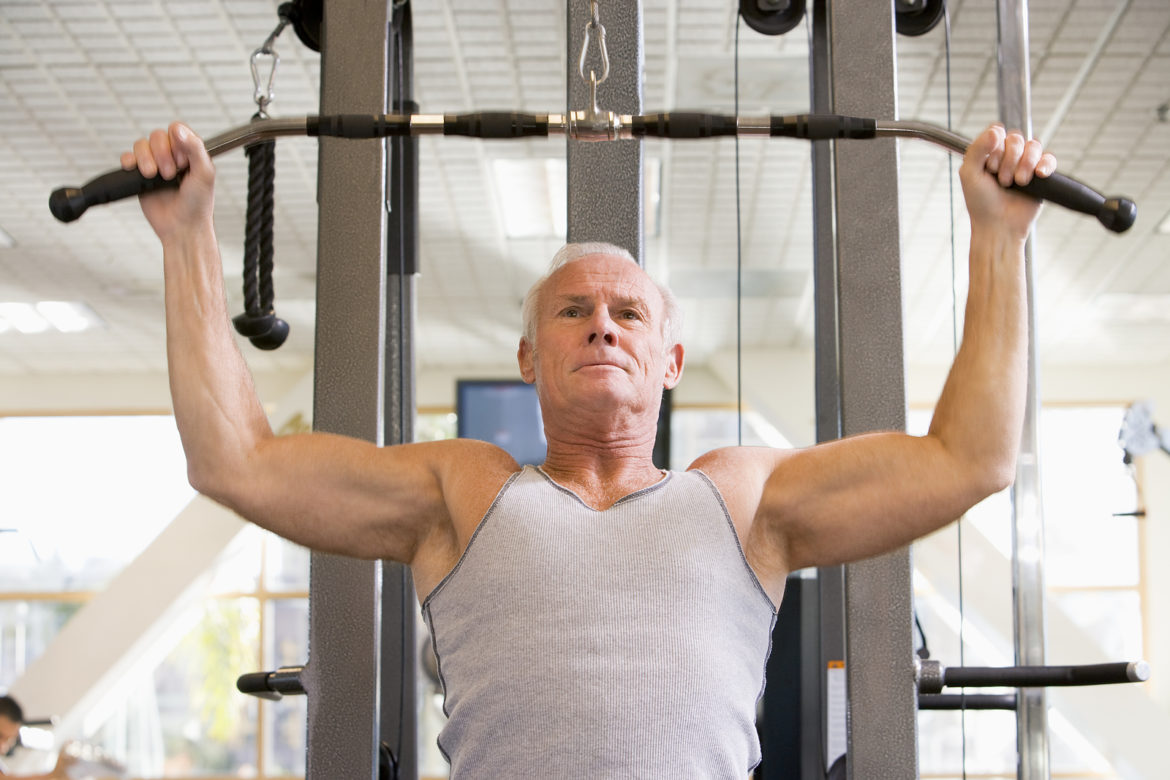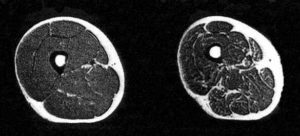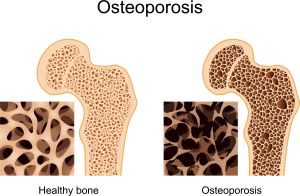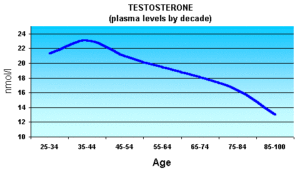
In this article, we are going to talk about why older people should regularly partake in resistance training. I find the older generations in general, shy away from weights training. Whether this because they are scared of hurting themselves, intimidated by the ‘macho’ weights room or just don’t know what to do. However, this form of exercise is exactly what is needed to combat the ageing process.
Physiological effects of Ageing
Sarcopenia
As we age there is a decline in muscle tissue in the body, which is called sarcopenia. This can amount to as much as 0.5-1% loss in muscle tissue per year after the age of 40, which will affect overall muscle mass and strength. (1,2) The reduction in muscles mass can have a negative effect on performing normal day to day tasks, which can lead to a loss of independence and quality of life. A drop in testosterone levels is seen as one reason for a reduction in muscle mass, but research is beginning to suggest that it could also be anabolic resistance. Anabolic resistance is when your muscles don’t respond to stimuli as well as they did when they were younger. Research has shown this occurs due to insulin and Branch Chain Amino Acids (BCAA’s found in protein foods) struggling to initiate protein translation in older subjects. This means the body does not use protein efficiently to create muscle. (3)
Osteoporosis
Secondly, an unfortunate problem older individuals suffer from is osteoporosis, which is a disease that makes bones weak and brittle. It has been found that osteoporosis is responsible for over 8.9 million fractures annually (4) When we reach middle age our bones slowly begin to lose their density. However with people who suffer from osteoporosis the problem is furthered as the replacement of new bone does not keep up with bone being broken down in the body. The bones become porous and fragile and prone to fractures. It is very common in older populations especially women who are postmenopausal.
Testosterone Levels
Another well-known issue for males is testosterone levels decreasing with age. This occurs again when we reach the mid-30s/40s. (see table) This affects the body in a number of undesirable ways such as low sex drive, decrease in energy levels, loss of muscle mass, increase in body fat, and decrease in bone mass. I think you’ll all agree that’s pretty rubbish.
Bodyfat Percentage
Finally another common symptom associated with ageing is an increase in bodyfat, which is generally put down to a slowing of peoples metabolism. The metabolism only slows slightly however, for example, a 70kg man who maintained a weight of 70kg as he aged would need 4-5% less energy (food) intake at 50 to maintain his weight and 10% by the time he reaches 70. For women, this increase in their waistlines is also believed to be due to hormonal changes after menopause. This weight gain normally displays itself around their waistline rather than evenly across the body. While similarly men’s drop-in test levels is used as a reason for weight gain. However new research seems to suggest that this body fat increase may have more to do with lifestyle changes (ie reduced activity, poor diet, stress, and lack of sleep)
Resistance training affects on Ageing
Now we have touched on some of the things that occur as we move into our senior years, lets look at how we can counteract this with weights training.
Muscle Increase
Weight training in older adults has been shown to eliminate age-related deficits in muscle mass and strength. A study follower a number of 60-70 yr olds who followed a 22 week resistance training regime. These individuals initially had significantly lower scores for muscle mass, size and strength compared to a group of 18-30 yr olds. However, these deficits were overcome after following a resistance training programme. (6) This shows that sarcopenia can be overcome and these gains will not only benefit you aesthetically but also aid you in day to day tasks, improving such things as mobility and fat levels.Muscle strength and balance will prevent falls, which is the most common reason older adults end up in hospital. Interestingly studies have shown that individuals who have a higher muscle mass also live longer. (7)
Fat Loss
Due to the increase in muscle mass experienced from weights training, we will also experience fat loss benefits. This is because the more muscle we have, the more calories that are burned at rest. Resting metabolic rate (RMR) is influenced by weights training, with research finding that individuals following a resistance programme lost more weight (14.5kg compared to 12.8kg of body fat) than individuals doing cardiovascular exercise. (10) Alongside this, you can aid your fat loss and metabolism with diet. If you aren’t training 4 days a week, don’t eat like you are. This is a really common problem with older clients who haven’t adapted their diet from when they were in their early 20s! You need to eat the optimal amount in line with your energy expenditure. Try to avoid eating bread, pasta, cakes and focus more on getting good quality protein, essential fats ( coconut oil, nuts, & avocados) and a variety of vegetables and carbs (Basmati rice, sweet potato etc).
Stronger Bones
Weight training also has a positive effect on bone mineral density (BMD) which means your bones are stronger and can counteract some of the symptoms of osteoporosis. (12) Alongside this, osteoporosis sufferers benefit from weights training as it reduces some of the risk factors of a fall, by improving muscle strength and balance.
Lower Blood Pressure and Healthier Heart
Weight training has also been shown to reduce the risk of heart disease and reduce blood pressure (11). As I’m sure you are aware this is a common problem in older populations, so any way we can get on top of this is a benefit.
Hormonal Changes
Resistance training has also been shown to increase certain hormones and neuro-chemicals. It has been shown that testosterone levels increase when we lift weights, whilst reducing your resting cortisol levels (8) Cortisol is an important hormone in regards to stress, to find out a little more about the hormones involved with stress, check out my stress-busting article. Similarly, sleep is improved with resistance training (9) meaning our energy levels improve.
Avoid Muscle and Joint Pain
Finally muscle and joint (M&J) pain is a common problem in older populations. There are a number of reasons for this, but 9 times out of 10 we can look towards our diet for the answer to the problem. The number one reason for M & J pain is chronic inflammation (different to when you swell up). This causes problems with joints and the digestive system, common symptoms include: diarrhoea, muscle and joint pain, bloating, and bad skin. The first thing to do is try cutting out certain foods that you feel may be causing you any level of discomfort ( gluten, dairy, eggs). Also, hit up the fish oil, this acts as a natural inflammatory (around 4g a day). Another reason for M&J pain is a lack of protein being consumed which can be quite common in older people. This is quite simply that you are not getting enough protein in your body to recover from your daily activities. If you are exercising 3 times a week, you should be looking to have around 2-3g of protein per kg of body weight. So to summarise, cut out foods that you don’t get on with, start supplementing fish oil, and increase your protein input.
There you go folks, I hope you can see the massive benefit that we can gain from following a resistance based programme. If you are one of these people who are solely focused on your cardiovascular exercise or are currently not doing anything. I urge you to get into that weights room and smash it, you will not only look great but you can experience a range of health benefits.
As a side note, we run a class for the more ‘mature’ gym goer. Stay Hip runs every Monday, Wednesday, and Friday at 1 pm.
References
- Janssen I, Ross R: Linking age-related changes in skeletal muscle mass and composition with metabolism and disease. J Nutr Health Aging 2005, 9:408-41
- Janssen I: Evolution of sarcopenia research. Appl Physiol Nutr Metab 2010, 35:707-712.
- Guillet C, Prod’homme M, Balage M, Gachon P, Giraudet C, Morin L, Grizard J, Boirie Y FASEB J: Impaired anabolic response of muscle protein synthesis is associated with S6K1 dysregulation in elderly humans.2004 Oct; 18(13):1586-7.
- Johnell O and Kanis JA: An estimate of the worldwide prevalence and disability associated with osteoporotic fractures.Osteoperosis Int 2006, 17:1726
- Simon D, Nahoul K, Charles MA,: Sex hormones, ageing, ethnicity, and insulin sensitivity in men: an overview of the the TELECOM study, Androgens and the Ageing Male 1996, pp. 85-102
- Candow, Darren G, Chillibeck, Phillip D, Abeysekara, Saman, Zello, Gordon A: Short-Term heavy resistance training eliminates age-related deficits in muscle mass and strength in older males. J Strength & Conditioning Research 2011, 25 2:326-333
- Srikantham P, Karlamangla AS: Muscle mass index as a predictor of longevity in older adults. , Amercian Journal of Medicine 2014, 127 6: 547-553
- Kraemer W, Haikkinen K et al: Effects of heavy resistance training on hormonal response patterns in younger vs older men. J of Applied Physiology, 1999 87 3:982-992
- Roveda et al: Effects of endurance and strength acute exercise on nights sleep quality. ISMJ, 2011 12 3: 113-124
- 10 Scott, C., Leary, M., et al: Energy Expenditure Characteristics of Weight Lifting: 2 Sets to Fatigue. J of Applied, Physiology, Nutrition, and Metabolism., 2011. 115-120.
- Braith R & Stewart K: Resistance exercise training, its role in the prevention of cardiovascular disease. Contemporary Review Cardv Medicine, 2006 113: 2642-265
- Hurley B & Roth S: Strength Training in the Elderly. J of Sports Med, 2000 30 4: 249-268




